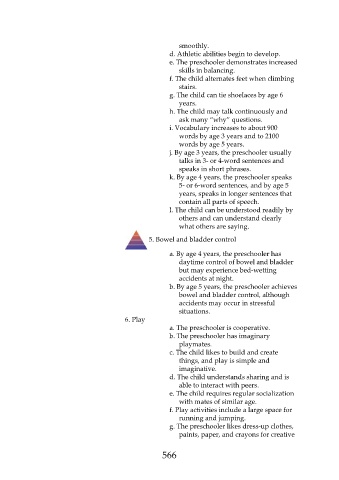Page 566 - Saunders Comprehensive Review For NCLEX-RN
P. 566
smoothly.
d. Athletic abilities begin to develop.
e. The preschooler demonstrates increased
skills in balancing.
f. The child alternates feet when climbing
stairs.
g. The child can tie shoelaces by age 6
years.
h. The child may talk continuously and
ask many “why” questions.
i. Vocabulary increases to about 900
words by age 3 years and to 2100
words by age 5 years.
j. By age 3 years, the preschooler usually
talks in 3- or 4-word sentences and
speaks in short phrases.
k. By age 4 years, the preschooler speaks
5- or 6-word sentences, and by age 5
years, speaks in longer sentences that
contain all parts of speech.
l. The child can be understood readily by
others and can understand clearly
what others are saying.
5. Bowel and bladder control
a. By age 4 years, the preschooler has
daytime control of bowel and bladder
but may experience bed-wetting
accidents at night.
b. By age 5 years, the preschooler achieves
bowel and bladder control, although
accidents may occur in stressful
situations.
6. Play
a. The preschooler is cooperative.
b. The preschooler has imaginary
playmates.
c. The child likes to build and create
things, and play is simple and
imaginative.
d. The child understands sharing and is
able to interact with peers.
e. The child requires regular socialization
with mates of similar age.
f. Play activities include a large space for
running and jumping.
g. The preschooler likes dress-up clothes,
paints, paper, and crayons for creative
566

